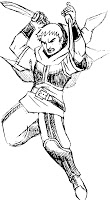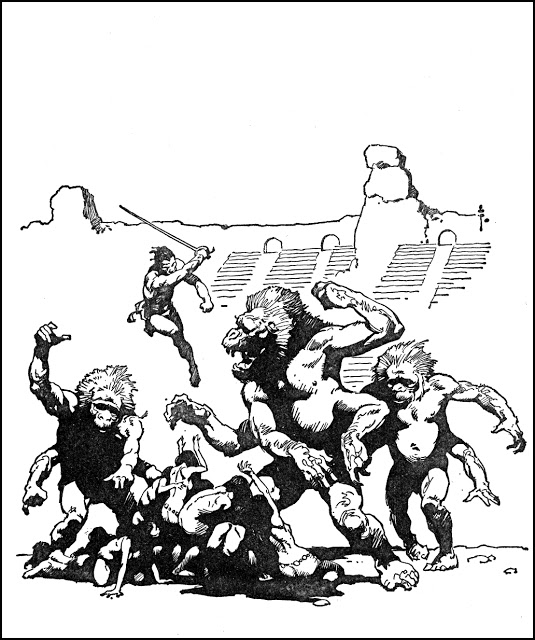© 2015 by Richard Smith ......... Version 1.1.1
The TFT my own house rules on jumping over bodies have wobbled between simple and easy to remember to more complex and often forgotten. This essay will nail down how this works. The goal is for these rules to be both logical, and simple enough to remember.
These rules will distinguish between the following environmental conditions:
These rules will distinguish between the following actions:

Note that the world record standing long jump is 3.47m, and the running long jump record is 8.95m.
To jump 1 hex is a 3vs (ST + DX) with +3 dice for each extra hex. In other words, it is:
(# of hexes * 3) dice vs (ST + DX)
However, each 2 meters running (in that turn) in the direction of the jump reduces the jump by 1 die. If the player blows the roll by 1 to 3 points, the jump is completed but they land prone in the target hex. If the GM is feeling kind, if you blow the roll by a 4 to 6 points, you land short, but may be able to grab onto the far side.
Making a jump costs you one movement point. If you don't have enough movement points to complete a jump, you end the turn, 'mid air'.
Example:
Impressive Jeoreff has a ST 19, DX 16 (ST + DX = 35 points). Being chased by a thundering whatsit, he wishes to jump a 7 meter wide pit. (7 * 3 =) 21 dice. But Jeoreff, has Running talent and has sprinted; he can move 24 hexes this turn. It costs him 8 movement points, to cross the 7 hex pit. So he runs, 20 hexes directly towards the pit before his jump. (He is now only 4 hexes into the jump so he is mid air.) This reduces the 21 die roll by 10 dice, so he only rolls 11 dice. He rolls a 37 on 11 dice so he blows the roll by two. At the start of next turn, he lands safely on the other side of the pit but falls prone. The sprinting cost him 1 fST.
Odd Notes: if the target hex is a meter higher, then triple the dice to roll. It is very difficult to jump any long distance AND gain height. If the target hex is lower, reduce the roll by 2 dice per meter lower it is. (But remember falling damage.)
Use the rules for jumping over flat spaces above, but add one die to the difficulty.
(Including the case where you are jumping a single body but it is moving or hostile.)
Use the rules for jumping over flat spaces above, but add two dice to the difficulty per body.
Requires a 3vsDX. Note that a single unmoving body is NOT considered rough ground.
(We assume that this is a friendly, as you would otherwise be pulled down into HTH - OR - it may involve trampling.)
Make a 3vsDX to remain standing. You are at -2 adj DX for rough ground.
(Including the case where one or more of these bodies may be moving.)
Make a X vs DX roll where X is equal to the number of bodies (minimum 3 dice). So to move onto a pile of 4 bodies will require a 4 vs DX roll. Remember you are on rough ground.
In the 3 cases above, if you spend 3 MA to carefully step onto the body, you may roll 3 dice less than the case above gives. So you can move onto a single body without a DX roll if you spend 3 MA to do so carefully.
Make a DX roll where X is equal to the number of bodies you are standing on. After calculating this value, you may reduce the roll by 3 dice if you do not move or change facing during the movement phase.
Example:
You are fighting on a pile of 2 bodies. This would normally be a 2 vs DX (but a minimum roll of 3 dice) at -2 for rough ground, but you didn't move so you get no rough ground penalty and the roll is reduced to zero dice. Therefore, no roll needed.
Example:
You are fighting on a pile of 5 bodies. This would normally be a 5 die roll (and at -2 for rough ground if you moved or changed facing), but you didn't move so this is reduced to a 2vsDX roll to remain standing.
OPTIONAL RULE:
How much difference is there between standing on 12 bodies or 13 bodies? The maximum the roll above can reach is 8 dice (5 dice if you are standing still).
This link takes you back to Rick's top level.
